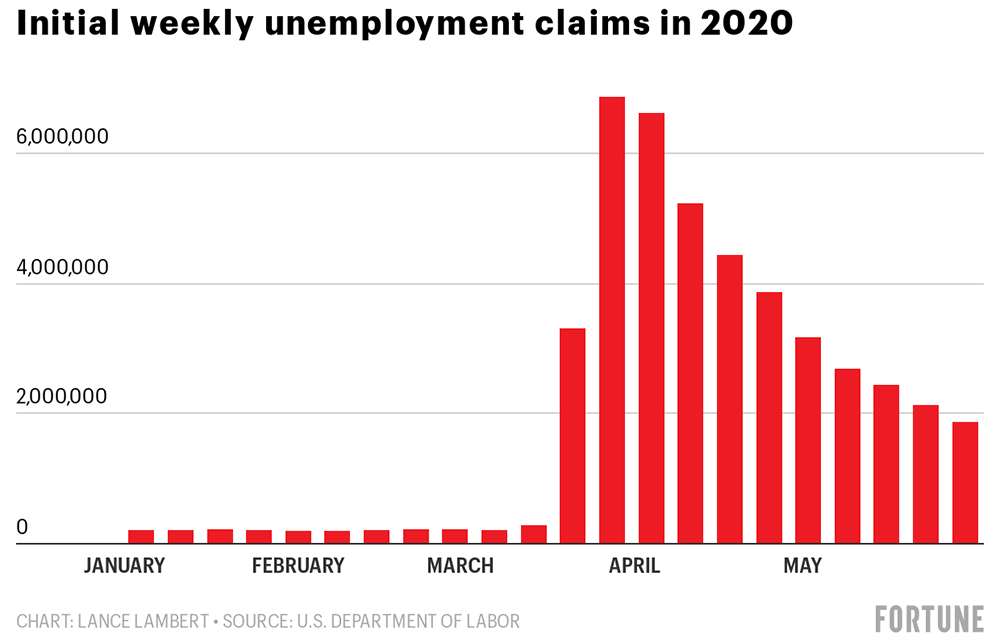美国失业补助申领人数超过4千万,但经济复苏可能已开始

根据美国劳工部的数据,在截至5月30日的一周内,美国有约190万人首次申领失业救济。自从美国经济因为新冠疫情而停摆以来,美国失业救济的申领人数令人震惊地达到了4,260万人,超过了美国较小的22个州的总人口。
美国首次申领失业救济的人数已经连续11周超过100万人,如此严重的就业损失在美国现代经济历史上是史无前例的。

但从整体经济状况来看,美国申领失业救济的总人数(或持续申请失业救济的人数)增加了64.9万人,达到2,150万人。截至5月9日的一周,该数据达到2,490万的最高峰,上一周减少了400万人。经济学家本希望持续申请失业救济的人数能继续减少。但美国失业救济的申领人数依旧比其最高峰减少了340万人。这表明雇主正在恢复招聘,经济开始从收缩向增长转变。Moody’s Analytics的首席经济学家马克•赞迪告诉《财富》杂志,经济数据表明新冠疫情导致的经济衰退已经在5月结束,现在经济已经开始复苏。
从经济衰退阶段,或者至少结束连续两个季度的经济增速下滑,进入经济复苏阶段,并不意味着经济风暴已经结束。美国经济可能需要几个月甚至几年时间才能完全恢复到疫情之前的水平。
在上周五发布的另外一份就业市场报告中,5月的失业率可能接近甚至超过20%。但赞迪预测5月的失业率将是最高峰,从6月开始失业率会下降,但至少在9月之前将始终维持在10%以上。
截至5月30日的一周内,首次申领失业救济的人数最多的州分别是加利福尼亚州(230,461人)、佛罗里达州(206,494)和佐治亚州(148,095)。同一周内,加州申领失业救济的总人数增加了618,432,而全国新增人数也只有649,000人。与此同时,俄亥俄州和密歇根州申领失业救济金的总人数减少幅度最大,分别减少了88,494人和69,911人。
目前申领失业救济金的美国人,除了本州的福利以外,还可以领取每周600美元的额外补助。但如果联邦政府不再延长这笔额外福利的期限,这600美元将从8月开始停止发放。(财富中文网)
译者:Biz
根据美国劳工部的数据,在截至5月30日的一周内,美国有约190万人首次申领失业救济。自从美国经济因为新冠疫情而停摆以来,美国失业救济的申领人数令人震惊地达到了4,260万人,超过了美国较小的22个州的总人口。
美国首次申领失业救济的人数已经连续11周超过100万人,如此严重的就业损失在美国现代经济历史上是史无前例的。
但从整体经济状况来看,美国申领失业救济的总人数(或持续申请失业救济的人数)增加了64.9万人,达到2,150万人。截至5月9日的一周,该数据达到2,490万的最高峰,上一周减少了400万人。经济学家本希望持续申请失业救济的人数能继续减少。但美国失业救济的申领人数依旧比其最高峰减少了340万人。这表明雇主正在恢复招聘,经济开始从收缩向增长转变。Moody’s Analytics的首席经济学家马克•赞迪告诉《财富》杂志,经济数据表明新冠疫情导致的经济衰退已经在5月结束,现在经济已经开始复苏。
从经济衰退阶段,或者至少结束连续两个季度的经济增速下滑,进入经济复苏阶段,并不意味着经济风暴已经结束。美国经济可能需要几个月甚至几年时间才能完全恢复到疫情之前的水平。
在上周五发布的另外一份就业市场报告中,5月的失业率可能接近甚至超过20%。但赞迪预测5月的失业率将是最高峰,从6月开始失业率会下降,但至少在9月之前将始终维持在10%以上。
截至5月30日的一周内,首次申领失业救济的人数最多的州分别是加利福尼亚州(230,461人)、佛罗里达州(206,494)和佐治亚州(148,095)。同一周内,加州申领失业救济的总人数增加了618,432,而全国新增人数也只有649,000人。与此同时,俄亥俄州和密歇根州申领失业救济金的总人数减少幅度最大,分别减少了88,494人和69,911人。
目前申领失业救济金的美国人,除了本州的福利以外,还可以领取每周600美元的额外补助。但如果联邦政府不再延长这笔额外福利的期限,这600美元将从8月开始停止发放。(财富中文网)
译者:Biz
Another 1.9 million Americans filed initial unemployment claims the week ending May 30, according to the U.S. Department of Labor. Since the start of the coronavirus shutdowns, a staggering 42.6 million jobless claims have been filed—greater than the combined population of America's 22 smallest states.
That marks 11 straight week of unemployment claims above 1 million, a period of job-destruction without precedent in modern American economic history.
But the bigger economic story is that the overall number of Americans on unemployment insurance—known as continuing claims—climbed 649,000 to 21.5 million. The prior week it had fallen 4 million from its peak of 24.9 million the week ending May 9. Economists were hoping that continuing claims would fall again, however, the total number of Americans on unemployment is still down 3.4 million from its peak. That is a sign that employers are bringing workers back, and the economy has moved from contraction to growth. Moody's Analytics chief economist Mark Zandi told Fortune that economic data points to the COVID-19 spurred recession ending in May, and that the economy is now in recovery.
Moving from the recession phase—at least two straight quarters of declining economic growth—and into the recovery phase doesn't mean the economic storm has passed. It could take months or years to fully rebound to pre-pandemic levels.
Another report card on the labor market comes with last Friday's jobs report, which could see an unemployment rate near or even over 20% in May. But that May jobless rate will likely be the peak, Zandi forecasts, with it then falling in June, but staying above 10% until at least September.
The most jobless claims during the week ending May 30 were in California (230,461), Florida (206,494), and Georgia (148,095). The total number of Californians on the unemployment rolls rose a staggering 618,432 the week ending May 23—almost as mush as the entire 649,000 national increase that week. Meanwhile, Ohio and Michigan saw the biggest declines in the overall number of residents on the unemployment rolls, falling 88,494 and 69,911, respectively.
Americans currently on the unemployment rolls are receiving an additional $600 weekly in benefits on top of their state benefits. However, unless that additional federal money is extended, that extra $600 will stop after the end of July.













